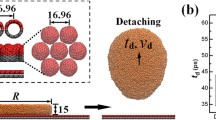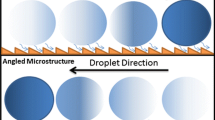Abstract
The motion of three-phase contact line of a droplet is always halted by the contact angle hysteresis on a common solid surface. In this work, the Ag/Cu surface and Cu(OH)2/Cu surface with water contact angle of 25.0° were fabricated and found favorable for two-component droplet moving. The droplet, water with propylene glycol in irregular shape could restore to a circle (top view) on these prepared surfaces. Inspired by the shape restoration, the directed motion of two-component droplet without back-end pinning was achieved on both the wedge-shaped Ag/Cu and Cu(OH)2/Cu composite surfaces. The two-component droplet moves in a way of the front-end spreading with the subsequent back-end shrinking. The needle-like Cu(OH)2 microstructure is more conducive to the front-end spreading, while the spheroidal Ag particles on Cu substrate is in favor of the back-end shrinking. In addition, the segmented Ag@Cu(OH)2/Cu wedge-shaped composite surfaces with Ag film on the narrow end of the track and Cu(OH)2 on the wide end could enhance the droplet moving. Finally, a micro-chemical reactor was designed capable of driving two dispersed droplets to move in a specific direction, converge, and then react with each other.










Similar content being viewed by others
References
Alheshibri MH, Rogers NG, Sommers AD, Eid KF (2012) Spontaneous movement of water droplets on patterned Cu and Al surfaces with wedge-shaped gradients. Appl Phys Lett 102(17):174103
Al-Sharafi A, Yilbas BS, Al-Zahrani A (2018) Ferro-liquid droplet heat transfer on water surface: effect of droplet volume on droplet fluidity. J Thermophys Heat Transf 32(4):1072–1087
Aziz H, Farhan NM, Vahedi Tafreshi H (2018) Effects of fiber wettability and size on droplet detachment residue. Exp Fluids 59(7):122
Benusiglio A, Cira NJ, Prakash M (2018) Two-component marangoni-contracted droplets: friction and shape. Soft Matter 14(37):7724–7730
Chen Y et al (2017) Design and fabrication of inverted tapered micro-pillars for spontaneously transporting liquid upward. Microfluid Nanofluid 22(1):9
Cira NJ, Benusiglio A, Prakash M (2015) Vapour-mediated sensing and motility in two-component droplets. Nature 519(7544):446–450
Deng S et al (2017) Controlled droplet transport to target on a high adhesion surface with multi-gradients. Sci Rep 7:45687
Edalatpour M, Liu L, Jacobi AM, Eid KF, Sommer AD (2018) Managing water on heat transfer surfaces: a critical review of techniques to modify surface wettability for applications with condensation or evaporation. Appl Energy 222:967–992
Hou YP, Peng SL, Dai LM, Zheng YM (2016) Droplet manipulation on wettable gradient surfaces with micro-/nano-hierarchical structure. Chem Mater 28(11):3625–3629
Hou K et al (2018) Facile generation of robust POSS-based superhydrophobic fabrics via thiol-ene click chemistry. Chem Eng J 332:150–159
Huang ZH et al (2012) Preparation and characterization of gradient wettability surface depending on controlling Cu(OH)(2) nanoribbon arrays growth on copper substrate. Appl Surf Sci 259:142–146
Ichimura K, Oh SK, Nakagawa M (2000) Light-driven motion of liquids on a photoresponsive surface. Science 288(5471):1624–1626
Katoh K, Tamura H, Sato E, Wakimoto T (2018) Control of droplet movement on an inclined wall with sawtoothed wettability pattern by applying ultrasonic vibration. Exp Fluids 59(9):141
Man XK, Doi M (2017) Vapor-induced motion of liquid droplets on an inert substrate. Phys Rev Lett 119(4):044502
Mugele F (2019) Droplet motion electrically controlled. Nature 572:445–446
Prakash R, Pabbaraju K, Wong S, Wong A, Tellier R, Kaler KVIS (2013) Droplet microfluidic chip based nucleic acid amplification and real-time detection of influenza viruses. J Electrochem Soc 161(2):B3083–B3093
Prakash R, Pabbaraju K, Wong S, Wong A, Tellier R, Kaler KVIS (2015) Multiplex, quantitative, reverse transcription PCR detection of influenza viruses using droplet microfluidic technology. Micromachines 6(1):63–79
Singh V, Wu CJ, Sheng YJ, Tsao HK (2017) Self-propulsion and shape restoration of aqueous drops on sulfobetaine silane surfaces. Langmuir 33(24):6182–6191
Song J, Zhang S, Wang K, Wang Y (2019) Synthesis of million molecular weight polyacrylamide with droplet flow microreactors. J Taiwan Inst Chem Eng 98:78–84
Soulie V, Karpitschka S, Lequien F, Prene P, Zemb T, Moehwald H, Riegler H (2015) The evaporation behavior of sessile droplets from aqueous saline solutions. Phys Chem Chem Phys 17(34):22296–22303
Thomas T, Unni HN (2019) LED-based opto-wetting and fluidic transport for droplet mixing. Microfluid Nanofluid 23(9):105
Tian D et al (2016) Electric field and gradient microstructure for cooperative driving of directional motion of underwater oil droplets. Adv Func Mater 26(44):7986–7992
Wang T et al (2018) Controlling directional liquid motion on micro- and nanocrystalline diamond/beta-SiC composite gradient films. Langmuir 34(4):1419–1428
Wong TS, Kang SH, Tang SKY, Smythe EJ, Hatton BD, Grinthal A, Aizenberg J (2011) Bioinspired self-repairing slippery surfaces with pressure-stable omniphobicity. Nature 477(7365):443–447
Xu B, Chen Z (2019) Molecular dynamics study of water vapor condensation on a composite wedge-shaped surface with multi wettability gradients. Int Commun Heat Mass Transf 105:65–72
Xu C, Liu H, Liang W, Zhu L, Li W, Chen H (2018) Creating gradient wetting surfaces via electroless displacement of zinc-coated carbon steel by nickel ions. Appl Surf Sci 434:940–949
Yonemoto Y, Suzuki S, Uenomachi S, Kunugi T (2018) Sliding behaviour of water-ethanol mixture droplets on inclined low-surface-energy solid. Int J Heat Mass Transf 120:1315–1324
Yong J et al (2014) Superhydrophobic PDMS surfaces with three-dimensional (3D) pattern-dependent controllable adhesion. Appl Surf Sci 288:579–583
Zheng YF, Cheng J, Zhou CL, Xing HT, Wen XF, Pi PH, Xu SP (2017) Droplet motion on a shape gradient surface. Langmuir 33(17):4172–4177
Zhou C et al (2017) A self-cleaning titanium mesh with underwater superoleophobicity for oil/water separation and aqueous pollutant degradation. Surf Coat Technol 313:55–62
Acknowledgments
This work was supported by the National Natural Science Foundation of China (21776094).
Author information
Authors and Affiliations
Corresponding author
Additional information
Publisher's Note
Springer Nature remains neutral with regard to jurisdictional claims in published maps and institutional affiliations.
Electronic supplementary material
Below is the link to the electronic supplementary material.
Supplementary file1 (AVI 6220 kb)
Rights and permissions
About this article
Cite this article
Zhang, H., Cheng, J., Xu, S. et al. Directed motion of two-component droplets on wedge-shaped composite copper surfaces without back-end pinning. Microfluid Nanofluid 24, 67 (2020). https://doi.org/10.1007/s10404-020-02376-w
Received:
Accepted:
Published:
DOI: https://doi.org/10.1007/s10404-020-02376-w




